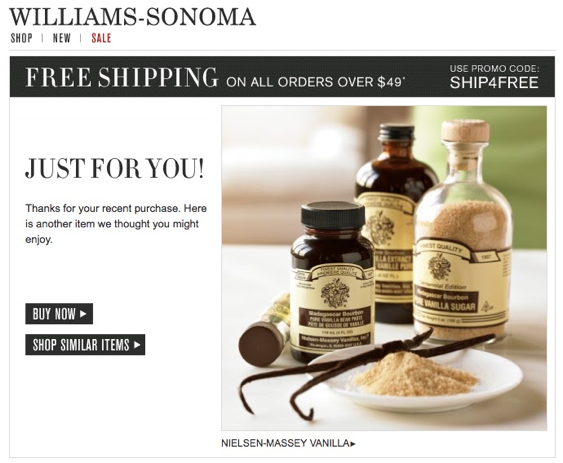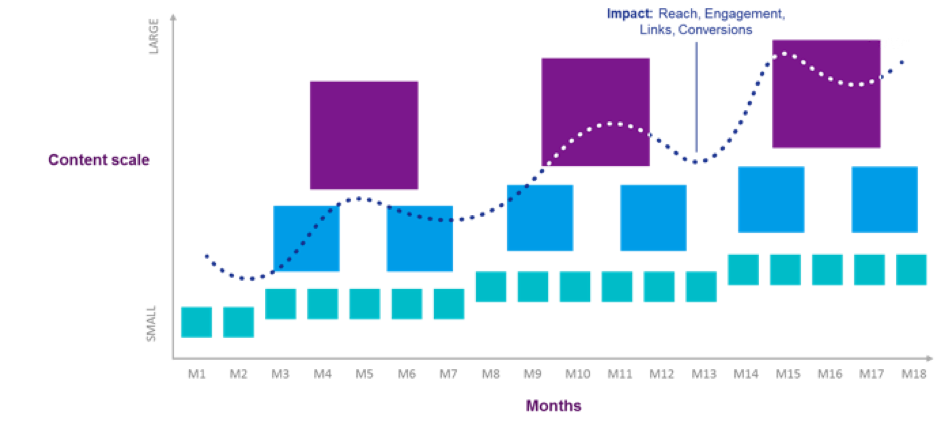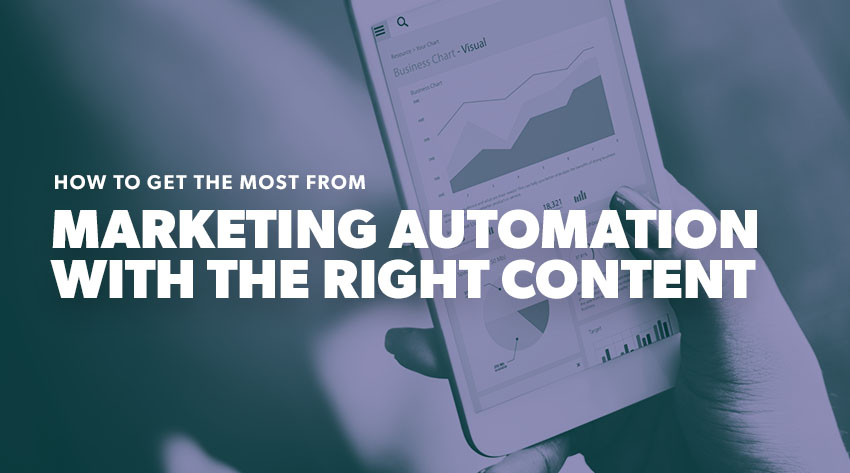According to Salesforce, 67% of marketing leaders are currently using a marketing automation platform, but how many are actually using it to its fullest potential? Marketing automation has many great benefits including:
- Prioritising lead outreach
- Getting cold leads sales ready
- Measuring the ROI from our marketing efforts
- Ensuring consistent marketing messaging
We’ve taken a look at how you can get the most out of your marketing automation simply through understanding your audience and creating the right type of content for them.
What is marketing automation?
We believe marketing automation is so much more than just the software and tools you use to streamline communication with your customers. At the heart of every digital conversation is content. Sure, it’s content that needs to be delivered at the right time and to the right people, but content nonetheless.
We can easily get lost in the growing number of features from tools like Hubspot and Pardot, but it’s important to unite these with engaging content that resonates with your audience. To do that, we first need to understand who your audience is…
Who is your audience?
Most businesses have a rough idea of who their audience is, but in order to deliver engaging content we need to know more than just the general demographics. Start by asking yourself the following questions to build a more detailed picture of who you want to reach.
- What online channels do they use? (i.e. social, blogs, forums)
- What else, besides your brand, are they interested in?
- What other brands do they engage with?
- What devices do they use?
- What do they want from you?
Once you have all the information to build a complete picture of your audience, you should put that data into personas. You can use our handy persona template to do that, or create your own. Personas help marketing teams make sense of all the data by presenting it in a much more illustrative way. They also help to set the structure for your marketing automation, in two ways.
- By enabling you to segment your audience so they only receive the content that’s most relevant to them.
- Allowing you to qualify and prioritise contacts to reach out to through lead scoring.
This campaign from Williams-Sonoma is a great example of how to implement this knowledge into your automation strategy. Here, they’ve used marketing automation to segment audiences by product types and interest categories, delivering tailored product recommendations based on past purchases.

If you want to structure your automation strategy, find our downloadable template here:
What does your customer journey look like?
Mapping out your customer journey is another central point of marketing automation. Not only does this allow us to see the progression of leads through the various stages of your sales funnel, but more importantly it gives us the opportunity to serve different types of content to keep them engaged with your brand.
Let’s face it, no one wants to receive a detailed product brochure if all they’ve done is signed up to your newsletter. Similarly, off message content delivered to someone who’s right on the cusp of buying can often do more harm than good. There certainly isn’t room for content for content's sake, and people can easily be turned off if they feel you don’t understand what they want from you.
In the words of Marketoonist Tom Fishburne, “The best marketing doesn’t feel like marketing”, and when we deliver the right content at the right time to our audience it’s appreciated rather than ignored.
The funnel below helps to illustrate the different types of content people are generally looking for at each stage of their journey. Merging this with your own customer data allows you to build a content strategy to maximise engagement with your contacts and help to move them through the funnel, all the way down to loyal customers.

By assigning a score to each interaction we can automatically move prospects from one stage to the next, and even devalue leads who haven’t engaged with your brand recently. Some interactions you can score include:
- Visiting your website
- Visiting a certain page of your website
- Downloading a piece of content
- Opening an email
- Clicking a link in an email
Weighting these scores all the way down to a specific piece of content enables you to manage your contacts to ensure they’re in the right life cycle stage to receive content that’s most relevant to them.
It’s important to note that the communication process doesn’t stop at the purchase stage. Engaging with customers post sale is just as important, if not more important. As the saying goes, and HBR reports, acquiring a new customer is anywhere from five to 25 times more expensive than retaining an existing one.
The below campaign from Nissan is another great example of how they’ve incorporated these life cycle stages into their marketing automation strategy, and importantly how customers are nurtured post purchase to keep engagement high.

How do we create content with purpose?
Now that we have an understanding of who our audience is, and the different stages they go through on their customer journey, we can begin to build a strategy that creates synergy between great content and great delivery.
The way we achieve this is by mapping our audience personas against their life cycle stages to create workflows. Think of these as the different tracks a contact will go through on their customer journey with you.
We’ve created a free template you can download to help you develop your workflows, together with a reporting matrix to keep track of things like open rate and CTR so you can measure and refine your content on an ongoing basis.

The first step is to audit what content you already have, and plot this on your workflow sheet as per our example above. This helps you to understand the gaps in your marketing automation that you need to fill, and what types of content to create in order to fill them.
The next step is to create those missing content pieces so you have a full table of relevant engaging content to implement into your automation workflows. As well as being right for your audience and their life cycle stage, you should also ensure you have a variety of content forms.
At Zazzle Media, we talk a lot about content flow. Our ‘Brand as Publisher’ ethos instills this content variety across all our clients, mixing larger feature pieces with smaller bite size content, interactive graphics and video, to ensure we’re capturing the full audience attention.

It’s important to view these as living workflows that you update when relevant with new audiences, new stages in the customer buying journey and new content. Marketing automation shouldn’t be turned on and left to run, it should be constantly updated, refined and optimised, based on the metrics you see each day.
How can we measure success?
Why do we implement marketing automation? Fundamentally, we do this to increase conversion and shorten sales cycles - all through increasing content engagement. There are a number of ways we can measure whether it’s actually making an impact on your bottom line, a key metric we know is the primary focus for almost half of CMOs today. We’ve listed our top three below:
- Sales revenue - the big one, sales revenue is an obvious metric we can track. However, the added benefit of automation is that it allows us to segment our marketing activities so we can understand what is delivering the biggest return on investment for your business.
- Cost per lead - similarly, through marketing automation we can tie in the source of business from activities like paid search or even events so you can see exactly where a customer has come from and how much you’ve spent acquiring them. This gives you a much fuller picture of your marketing spend and where to focus your efforts.
- Conversion rate - by tracking the total number of inbound leads, we’re able to see the conversion rate of those going through the nurture process and how that is changing over time. Hopefully, the more you measure and refine your content the better conversion rate you will see, meaning much more bang for your buck.
Summary
Marketing automation is much more than just the tools you use. Creating the right content by understanding your audience and the customer buying journey will ensure you keep your prospects engaged at each stage of the sales cycle.
Furthermore, structuring workflows in this way allows you to measure each interaction independently and refine over time, allowing you to test new content strategies and overall, get the most from your marketing automation investment.
For more help with your marketing automation, take a look at our template here:
Sign up for our monthly newsletter and follow us on social media for the latest news.






 Proudly part of IPG Mediabrands
Proudly part of IPG Mediabrands